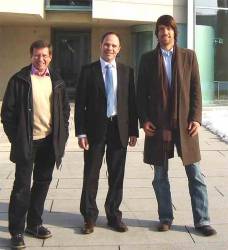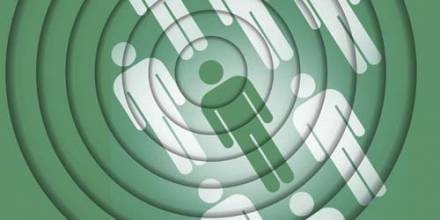 From left, Johann Furthner, Walter Päffgen (managing director of Galileo Control Center), and Steffen Thölert
From left, Johann Furthner, Walter Päffgen (managing director of Galileo Control Center), and Steffen ThölertUp close and personal, the curved aluminum antenna dish at Weilheim — painted white and aimed vaguely skyward, with a big Krupp corporate logo on the front — looked a lot bigger than 30 meters across. And when we climbed up the steel stairs to the platform half-way up the dish, the ground looked a lot further away than 20 meters.
And that was before Peter, overseeing the DLR facility this late winter afternoon, flipped the switch and set the antenna in motion — 240 degrees each direction horizontally, 90 degrees in the vertical.
Up close and personal, the curved aluminum antenna dish at Weilheim — painted white and aimed vaguely skyward, with a big Krupp corporate logo on the front — looked a lot bigger than 30 meters across. And when we climbed up the steel stairs to the platform half-way up the dish, the ground looked a lot further away than 20 meters.
And that was before Peter, overseeing the DLR facility this late winter afternoon, flipped the switch and set the antenna in motion — 240 degrees each direction horizontally, 90 degrees in the vertical.
The motor driving the dish can rotate it about 1.5 degrees per second, our hosts told us. But they usually keep it under half a degree per second. No autobahn excesses here. Still, it felt a bit like the slow-motion equivalent of a Tilt-a-Whirl. All in the pursuit of scientific research, of course.
After about four hours of shuttling between buildings to view projects at the German Aerospace Center (Oberpfaffenhoffen) last Friday (March 12), DLR researchers Steffen Thölert and Johann Furthner had packed Richard Fischer and me into Johann’s car and drove about 35 kilometers southwest to DLR’s ground station at Weilhem.
Built in 1972, one of the antenna’s first missions was to operate and control the Helios 1 and 2 probes in a joint U.S.–German mission that studied the solar wind from a path that stretched inside Mercury’s orbit (at perihelion). The Helios instrumentation is still bolted into place inside the cabin where the Galileo TT&C package now resides, but only the latter is now operational.
DLR scientists at Oberpfaffenhofen can track GIOVE-A and –B remotely using the big dish at Weilheim and also collect data from L-band signals of other GNSS satellites and the operational Galileo spacecraft to be launched beginning next year.
Richard kidded our hosts about the opportunity to impress their girlfriends by bringing them out for a picnic at the antenna or taking advantage of the concave dish lying flush with the ground to get in a little skate-boarding. Steffen, at least, looked willing to give the suggestion a little more thought.
By the way, pay no attention to the smaller, recently built dishes on the right side of the accompanying photo at Weilheim. They are tracking German military assets such as the SAR-Lupe reconnaissance satellites, built coincidentally (or not) by OHB-System, the Bremen-based company that recently captured the €566-million (US$811.2-million) contract to build the first 14 Galileo satellites.
Inside GNSS editor Glen Gibbons recently returned from the 2010 Munich Satellite Navigation Summit and a visit to the DLR in Oberpfaffenhofen, Germany.


